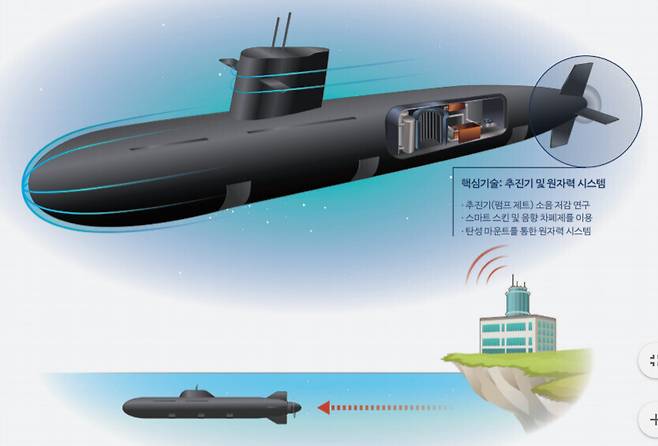S. Korea proposes plans for nuclear submarine, backpedals after stirring up controversy
전체 맥락을 이해하기 위해서는 본문 보기를 권장합니다.
The almanac described this as a "submarine depot ship that can operate without personnel through the use of a next-generation nuclear system that runs on low-enriched uranium and a next-generation concept of intrinsically safe nuclear power."
But when critics drew a connection between the almanac and that possibility, the ADD released a statement on the afternoon of Jan. 20 explaining that the reference to a "nuclear-powered submarine depot ship" had actually been a mistake for a "multipurpose unmanned submersible."
이 글자크기로 변경됩니다.
(예시) 가장 빠른 뉴스가 있고 다양한 정보, 쌍방향 소통이 숨쉬는 다음뉴스를 만나보세요. 다음뉴스는 국내외 주요이슈와 실시간 속보, 문화생활 및 다양한 분야의 뉴스를 입체적으로 전달하고 있습니다.

South Korean government agencies have suggested using nuclear technology in future submarines, the latest in several references to this fraught subject.
The idea came up in a list of conceptual weapon systems proposed by the Defense Acquisition Program Administration (DAPA) and the Agency for Defense Development (ADD). One of the items on the list was a nuclear-powered unmanned nuclear depot ship.
When the idea stirred up controversy, the ADD backpedaled by releasing a statement asserting that the conceptual submarine’s source of propulsion hasn’t been determined.
On the morning of Jan. 20, the ADD posted on its website an almanac of defense systems proposed in a defense project that seeks to develop technology to meet future challenges. The 14th conceptual weapon system in the almanac, which was jointly published by DAPA, was a nuclear-powered submarine depot ship.
The almanac described this as a “submarine depot ship that can operate without personnel through the use of a next-generation nuclear system that runs on low-enriched uranium and a next-generation concept of intrinsically safe nuclear power.”
The almanac summarized the proposed ship’s operations as follows. “This would be deployed on reconnaissance and search and rescue operations, as well as on antisubmarine and mine-laying operations. In an emergency, its missions would be to launch torpedoes and lay mines capable of quickly striking enemy submarines and surface ships and to carry out surveillance and reconnaissance in specific areas and identify danger signals.”
Despite being unmanned, this ship would apparently be equipped to carry out all the missions of the manned submarines currently operated by the South Korean Navy.
“In times of peace, drones would be deployed to operate a reconnaissance system capable of surface, underwater, and aerial surveillance,” the almanac also said, explaining that, as a depot ship, the vessel could carry around reconnaissance drones for deployment in the air, on the surface and underwater when necessary.
The almanac’s mention of a nuclear-powered unmanned submarine depot ship was notable since it followed suggestive comments about nuclear submarines made by both South and North Korea.
In his project report for the 8th Congress of the Workers’ Party of Korea (WPK), North Korean leader Kim Jong-un officially acknowledged that the North is developing a submarine capable of launching nuclear weapons. Kim said that research on the submarine design was complete and that the design had now entered the final review stage.
South Korean officials have hinted that they intend to develop a nuclear-powered submarine. “The next-generation submarine will be equipped with an engine that uses nuclear fuel,” said Kim Hyun-chong, second deputy director of the National Security Office, in an interview in July 2020.
In a press release about the almanac’s publication, ADD President Nam Se-gyu said that the almanac would “provide the guidance needed for developing high-tech weapon systems of the future that would apply the technologies covered in this project.”
“We hope the almanac will help us imagine innovative changes in the battlegrounds of the future,” Nam said. The information published in the almanac suggests that the government is inching closer to developing nuclear-powered submarines.
But when critics drew a connection between the almanac and that possibility, the ADD released a statement on the afternoon of Jan. 20 explaining that the reference to a “nuclear-powered submarine depot ship” had actually been a mistake for a “multipurpose unmanned submersible.”
“The almanac that was initially posted was an interim draft rather than the final approved version, leading to this misunderstanding. Nuclear power is one of the options for the propulsion of the multipurpose unmanned submersible, but no decision has been made yet,” an ADD spokesperson said.
The almanac also introduces 17 technological objectives, including designing and producing a cluster of synthetic-aperture radar (SAR) microsatellites and acquiring operational capabilities. The technological objectives were identified by the “future challenges” defense project, launched in 2018.
The almanac goes on to describe how those technologies could be applied to 21 conceptual weapon systems, including a comprehensive surveillance and reconnaissance system and an AI-based multifunction radar.
The updated almanac, in Korean, can be downloaded from the ADD website (www.add.re.kr).
By Park Byong-su, senior staff writer
Please direct comments or questions to [english@hani.co.kr]
Copyright © 한겨레. 무단전재 및 재배포 금지.
- ‘초콜릿폰’에서 ‘롤러블폰’까지…‘혁신’의 엘지는 왜 쓴잔 마셨나
- [영상] 손으로 말을 건네듯…바이든 취임식 빛낸 22살 시인
- 김진욱 공수처장 취임 “절제된 수사…여·야 아닌 국민 편 들겠다”
- 해리스, 보라색 옷 입고 라틴계 여성 대법관 앞에서 선서
- “어떤 식으로든 돌아온다”…떠나는 트럼프의 마지막 말
- [정치BAR] ‘블링컨 발언’ 통해 엿보는 북-미 대화 촉진 3대 힌트는?
- ‘여성은 전리품?’ 웹툰 속 성차별 사례 살펴보니
- [ESC] 주방 수납을 바꾸세요, 설거지로 지친 삶이 바뀝니다
- ‘박사방’ 공범들…‘부따’ 강훈 징역 15년·‘김승민’ 징역 11년
- [ESC] 집에 대한 생각 바꾸면…‘월세 대신 주차비’ 내도 괜찮아